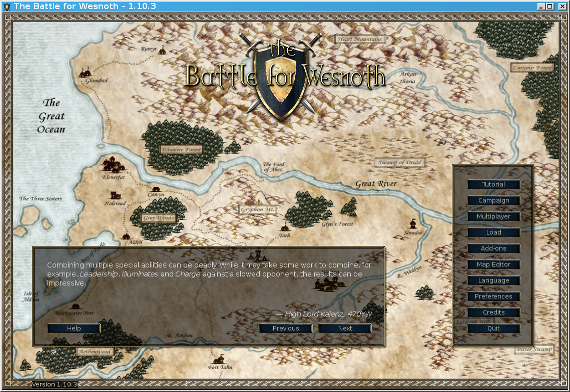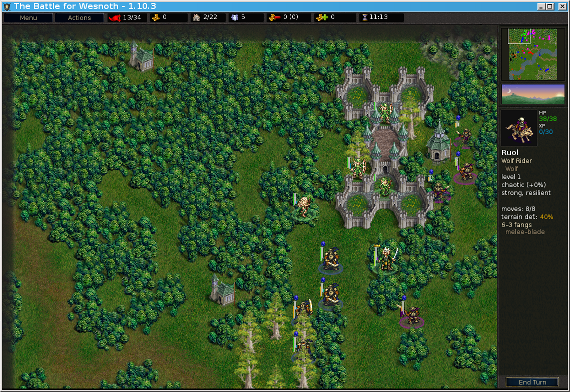My Wesnoth addiction

Off the Beat: Bruce Byfield's Blog
Except briefly for a review, I haven't installed Steam. Nor have I had a Windows partition for games for over a decade. It's not that I dislike games -- to be honest, the problem is I like them too much. I have a hard enough time keeping PySol, GNU Backgammon, and Kajongg from eating up most of my work hours without installing more elaborate diversions. But worse of all is Battle of Wesnoth, which could occupy days at a time, if I let it.
You wouldn't think Wesnoth was so potentially harmful, just to look at it. It's turn-based, not real time, and its two-dimensional might have been state-of-the-art fifteen years ago. But its strategies are both easy to learn and challenging to master, which makes the limitations are barely noticeable.

Consider: At its most basic, Wesnoth is a strategy in which you play against one or more opponents, either live or AI. Solo games are often particularly interesting, because a series of scenarios are organzied into campaigns by a loose story. Each scenario has one or more objectives -- which can change as the turns progress -- and you have to decide what tactics and use of resources will help you realize those objectives.
Elementary tactics
On the map, you generally have a keep, from which your leader can recruit the units available to you side in the scenario. Scattered around the maps are villages, which award you gold each turn and help any unit on them to heal faster. Often, a sensible strategy is to control villages to increase your income per turn, but when your enemy is scheduled for reinforcements or time is limited, you might want to consider the advantages of blitzkreig tactics instead, usually with cavalry.
Then there is your purchase of units. Most Wesnoth scenarios use one or more of the standard fantasy races: humans, elves, dwarves, orcs, the undead, and others. Each of these races offers different sets of units, some of them with unique capacities. For instance, human mages can heal and have a strong magical attack, but few hit points. Simiarly, dwarves with thundersticks have powerful but unreliable muskets, while orc assassins can poison other units with their throwing knives while being vulnerable to a face-to-face attack.
One of your challenges is to find the right combination of units to help you win. For example, it is a good idea to have both regular forces and forces with a ranged attack, so that one can reinforce the other. You might also want to consider fast-moving scouts, agile light infantry, and heavy conventional forces, as well as units with healing or leadership abilities that can move in support of other units.
Your available money is one consideration. Especially late in the game, you might find yourself pumping out the cheapest units available just so you can keep fighting. Alternatively, you might prefer to hang on until you can afford stronger, more expensive units that might allow you to start advancing against.
Another consideration is your enemy. Every type of unit has attacks to which they are resistant and others to which they are vulnerable. An undead skeleton, for instance, is usually damaged less by an archer than by a magical attack. More mundanely, an opponent with mostly mounted units might require that you invest in mounted units yourself so that you can move as quickly as they can.

You need to consider, too, the terrain on which you are fighting. Units defending a river from enemies attempting to cross it, or units at a higher elevation usually have an advantage at any time. But in addition, some units are stronger at one time of day than at other, and some units are better-suited to a particular terrains -- elves, for instance, have combat advantages in forests, and dwarves when underground. You need to think of what time of day it will be when your units engage the enemy, and what terrain they might be fighting on.
Elements of strategy
If you are running a campaign, one of your long-term concerns should be the promotion of units. In later scenarios, you are likely to need experienced units, if only because your enemies are likely to be more experienced, as well. As you fight, you may want to nurse particular units along so that they gain experience. In particular, as you start another scenario, you may want to begin with survivors who near to gaining another level of experience and can improve in one or two turns. Once a unit has gained experience, you can turn your attention to making weaker units stronger.
Most of all, you have to decide which strategies you will use on the battlefield. Unlike in many war-games, in Wesnoth the biggest army does not always win. A small army with experienced units that takes full-advantage of terrain can last a surprisingly long time, and, even if it cannot win, it can often leave opponents in no shape to drive an attack home. Conversely, a mass frontal attack is only occasionally the best strategy.
Because of the importance of villages for income and healing, in some circumstances, your best strategy might be to takeover as many of your enemies' villages as possible, enriching you and impoverishing them. At other times, you might want to spread units as widely as possible to slow down an enemy attack while the rest of your units retreat and regroup. In other cases, scenario objectives specify that you need to flee a much larger enemy. Some particularly interesting scenarios require you to pass unnoticed through enemy lines and back again to achieve your goals.
Simplicity and realism
All these considerations apply to a greater or lesser extent, whether you are playing a combat game of the kind for which Wesnoth was originally designed, or one of the more recent attempts at roleplaying or even modern combat. And since you almost never have enough gold or units to do anything you want, Wesnoth generally involves a weighing of limitations, deciding which concerns need immediate attention and which can be delayed a turn or two.
But the real appeal of Battle of Wesnoth is that way that, with a few simple rules for movement and supply, it manages to simulate the considerations of combat and campaigning with what appears to be a high degree of realism.
In fact, Wesnoth is one of the few war-games I have come across in which elementary tactics such as outflanking or a strategic withdrawal actually seem to work approximately as they do in real life. Your tactical and strategic choices and how you attempt to balance them always have immediate, obvious consequences.
Wesnoth is not just a fantasy of war, but a game about resources and decision-making based on multiple considerations. Instead of being a vicarious blood-bath, Wesnoth is a thinking person's game, capable of endless variety and challenges -- all of which is precisely why it is such a danger to my productivity and why I fear it more than any other game on my computer. If there is a game available hat is more distracting, I don't think I should know about it.
comments powered by DisqusSubscribe to our Linux Newsletters
Find Linux and Open Source Jobs
Subscribe to our ADMIN Newsletters
Support Our Work
Linux Magazine content is made possible with support from readers like you. Please consider contributing when you’ve found an article to be beneficial.

News
-
Parrot OS Switches to KDE Plasma Desktop
Yet another distro is making the move to the KDE Plasma desktop.
-
TUXEDO Announces Gemini 17
TUXEDO Computers has released the fourth generation of its Gemini laptop with plenty of updates.
-
Two New Distros Adopt Enlightenment
MX Moksha and AV Linux 25 join ranks with Bodhi Linux and embrace the Enlightenment desktop.
-
Solus Linux 4.8 Removes Python 2
Solus Linux 4.8 has been released with the latest Linux kernel, updated desktops, and a key removal.
-
Zorin OS 18 Hits over a Million Downloads
If you doubt Linux isn't gaining popularity, you only have to look at Zorin OS's download numbers.
-
TUXEDO Computers Scraps Snapdragon X1E-Based Laptop
Due to issues with a Snapdragon CPU, TUXEDO Computers has cancelled its plans to release a laptop based on this elite hardware.
-
Debian Unleashes Debian Libre Live
Debian Libre Live keeps your machine free of proprietary software.
-
Valve Announces Pending Release of Steam Machine
Shout it to the heavens: Steam Machine, powered by Linux, is set to arrive in 2026.
-
Happy Birthday, ADMIN Magazine!
ADMIN is celebrating its 15th anniversary with issue #90.
-
Another Linux Malware Discovered
Russian hackers use Hyper-V to hide malware within Linux virtual machines.
